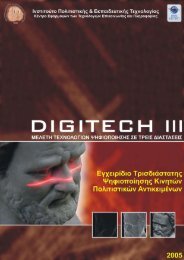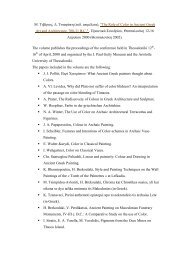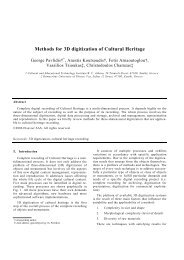a versatile workflow for 3d reconstructions and modelling
a versatile workflow for 3d reconstructions and modelling
a versatile workflow for 3d reconstructions and modelling
Create successful ePaper yourself
Turn your PDF publications into a flip-book with our unique Google optimized e-Paper software.
can be considered as principal criteria when selecting such<br />
software. Open Source Maturity Model (OSMM), Business<br />
Readiness Rating (BRR) <strong>and</strong> Method <strong>for</strong> Qualification <strong>and</strong><br />
Selection of Open Source Software (QSOS) are evaluation<br />
frameworks that have been arisen in order to compare <strong>and</strong><br />
assess OSS.<br />
In our case though, the software selection was biased by the<br />
limited number of OSS that are capable to per<strong>for</strong>m the<br />
specialised functions required in a 3D reconstruction project.<br />
Nevertheless, the identified applications have good reputation<br />
<strong>for</strong> per<strong>for</strong>mance <strong>and</strong> they provide some functionality that can<br />
also be found in commercial software. Thus, they <strong>for</strong>m a stable<br />
while <strong>versatile</strong> software arsenal which is applicable in low<br />
budget 3D reconstruction projects. The following software<br />
components compile the proposed toolset:<br />
a) Panorama Tools is a collection of software programs<br />
used <strong>for</strong> creating panoramas from multiple images. The<br />
core software was originally written by Prof. Helmut<br />
Dersch of the Fachhochschule Furtwangen. The software<br />
includes ptpicker <strong>and</strong> ptstereo software components to<br />
create sparse 3D meshes based on the shape from stereo<br />
technique from pairs or many images (Dersch, 2003).<br />
b) Hugin is a cross-plat<strong>for</strong>m open source panorama<br />
photo stitching program developed by Pablo d'Angelo. It is<br />
a frontend GUI <strong>for</strong> the Panorama Tools.<br />
c) The GNU Image Manipulation Program (The Gimp)<br />
is a raster graphics editor <strong>for</strong> creating <strong>and</strong> processing<br />
bitmap graphics. It also provides partial support <strong>for</strong> vector<br />
graphics. The project was initiated in 1995 by Spencer<br />
Kimball <strong>and</strong> Peter Mattis <strong>and</strong> is now maintained by a<br />
group of volunteers; it is licensed under the GNU General<br />
Public License.<br />
d) Blender is the open source software <strong>for</strong> 3D <strong>modelling</strong>,<br />
animation, rendering, post-production, interactive creation<br />
<strong>and</strong> playback. Available <strong>for</strong> all major operating systems<br />
under the GNU general public license.<br />
e) Voodoo Camera Tracker is a camera tracking tool <strong>for</strong><br />
the integration of virtual <strong>and</strong> real scenes. It can provide a<br />
coarse 3D point cloud based on feature points that are<br />
automatically detected <strong>and</strong> extracted from a video<br />
sequence. This non-commercial software tool is developed<br />
<strong>for</strong> research purpose at the Laboratorium fuer<br />
In<strong>for</strong>mationstechnologie, University of Hannover.<br />
f) VeCAD-Photogrammetry is a simple tool <strong>for</strong><br />
architectural photogrammetry that per<strong>for</strong>ms basic<br />
processes such as photogrammetric image rectification<br />
using vanishing points <strong>and</strong> photogrammetric rectification<br />
based on measured control points (Tsioukas, 2007).<br />
g) Meshlab is an open source, portable, <strong>and</strong> extensible<br />
system <strong>for</strong> the processing <strong>and</strong> editing of unstructured 3D<br />
triangular meshes <strong>and</strong> point clouds (Cignoni, 2008). It<br />
provides a set of tools <strong>for</strong> editing, cleaning, healing,<br />
inspecting, rendering <strong>and</strong> data <strong>for</strong>mat converting.<br />
h) VCG ShadeVis computes a simple, static per-vertex<br />
ambient term. This effect, commonly known as ambient<br />
occlusion, is aimed at providing more faithful shading <strong>for</strong><br />
realtime rendering (Cignoni, 2008b).<br />
VeCAD-Photogrammetry, Hugin <strong>and</strong> Panorama Tools compose<br />
the Image Rectification Toolkit (IRT) while Blender, Meshlab,<br />
VCG ShadeVis <strong>and</strong> Voodoo Camera Tracker compose the<br />
Geometry Modelling Toolkit (GMT).<br />
2.2 The Open Source Software 3D Reconstruction<br />
Workflow (3D-OSSRW)<br />
The 3D <strong>reconstructions</strong> that are produced by 3D-OSSRW are<br />
mainly considered <strong>for</strong> promotional purposes <strong>and</strong> not <strong>for</strong> digital<br />
archiving or scientific study. They are applicable <strong>for</strong> realistic<br />
real time walkthroughs over the web. Figure 1 depicts the two<br />
main phases of the proposed <strong>workflow</strong>. These are:<br />
• The Data Acquisition Phase (DAP) that denotes the<br />
actual fieldwork.<br />
• The Reconstruction Phase (REP) which is per<strong>for</strong>med<br />
with the use of the proposed OSS arsenal (IRT <strong>and</strong><br />
GMT).<br />
Figure 1: The two phases of the proposed 3D-OSSRW<br />
2.2.1 The Data Acquisition Phase (DAP)<br />
DAP comprises of empirical procedures that do not require the<br />
use of any of the proposed software applications. More<br />
specifically, during this phase a thorough study of the target site<br />
is per<strong>for</strong>med in order to decide on which of the geometric<br />
features of the buildings <strong>and</strong> surroundings are going to be<br />
modelled. It is a significant phase as the empiric method that is<br />
going to be followed <strong>for</strong> measurements <strong>and</strong> photo shooting will<br />
be driven by the decisions made at this point. This decision<br />
phase could be described as a ‘mental polygonal <strong>modelling</strong> of<br />
the site’ per<strong>for</strong>med by the development team. Experience on 3D<br />
computer graphics <strong>modelling</strong> is considered as a subjective<br />
criterion on wisely identifying those parts of the real world that<br />
are going to be modelled. Thus, DAP is partially dependent on<br />
the developer’s experience.<br />
It is a fact that our brain has two major paths <strong>for</strong> processing<br />
visual in<strong>for</strong>mation, the ‘where path’ that determines object<br />
locations <strong>and</strong> the ‘what path’ <strong>for</strong> identifying objects (Cho et al.,<br />
2003). The previous statement is highly correlated to real time<br />
virtual reality applications such as 3D walkthroughs. The<br />
evaluation of the area by identifying characteristic features of<br />
the objects is an important factor that affects realism (the ‘what<br />
path’) of the final 3D model. It is important <strong>for</strong> a development<br />
team to have in mind that the introduction of real time 3D<br />
graphics techniques derived from the multimillion computer<br />
game industry is always an advantage in the visualisation of 3D<br />
<strong>reconstructions</strong>. Fundamental techniques such as billboards,<br />
tiled textured maps, vertex paint shadowing, ambient occlusion<br />
<strong>and</strong> ray trace shadow baking techniques in combination with





